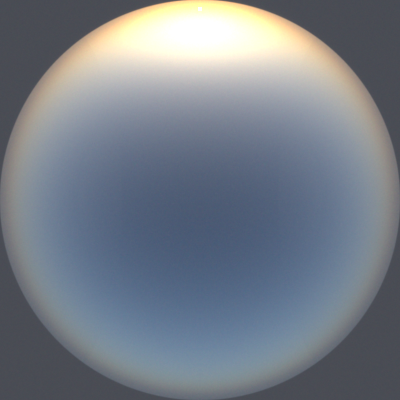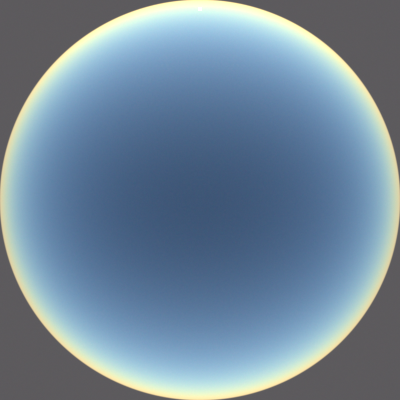A couple weeks ago, I noticed that, in my sunset and twilight renders, towards the zenith, the sky looked fairly gray, while in real life it looks fairly blue. I realized that implementing the actual solar spectral irradiance would make the sky appear slightly bluer, but I didn't expect the effect to be strong enough to explain the discrepancy between my images and real life. Then I stumbled across something very interesting on
Wikipedia:
According to Craig Bohren, "preferential absorption of sunlight by ozone over long horizon paths gives the zenith sky its blueness when the sun is near the horizon".
I proceeded to check the referenced
Craig Bohren paper, where the statement was explained in more detail. In particular, the Chappuis absorption band of ozone, "which extends from about 450 to 750 nm and peaks at around 600 nm", is responsible for absorbing light of longer wavelengths in the visible spectrum, thus making the sky appear more blue. He also said that
In the absence of molecular absorption, the spectrum of the zenith sky would be essentially that of the zenith sun (although greatly reduced in radiance)
Bohren referenced a 1953 paper by Hulbert, who originally pointed out this explanation of this blueness:
Explanation of the Brightness and Color of the Sky, Particularly the Twilight Sky. Here's an excerpt from the abstract of that paper:
Calculation showed that during the day the clear sky is blue according to Rayleigh, and that ozone has little effect on the color of the daylight sky. But near sunset and throughout twilight ozone affects the sky color profoundly. For example, in the absence of ozone the zenith sky would be a grayish green-blue at sunset becoming yellowish in twilight, but with ozone the zenith sky is blue at sunset and throughout twilight (as is observed), the blue at sunset being due about 1/3 to Rayleigh and 2/3 to ozone, and during twilight wholly to ozone.
I also found a paper from 1973,
The Influence of Ozone and Aerosols on the Brightness and Color of the Twilight Sky, that confirms the effect of ozone on the color of the twilight sky using computer simulations.
I decided that I needed to include ozone absorption in my sky renderer, so I searched around for spectral ozone absorption data, and eventually came across recent (2011), high-precision, absorption cross-section measurements
here. The data is provided in 0.01 nanometer increments, which is way too precise for my purposes, so I wrote some code to convert the data to 5 nanometer increments, averaging 500 data points to create each new data point. The data is provided for 11 different temperatures. They're similar enough that I probably could have just used one, or averaged them all together, but I decided to use all of them anyway. When a query is made, I just look up the data at the closest temperature and wavelength—I decided that interpolation was probably overkill in this case.
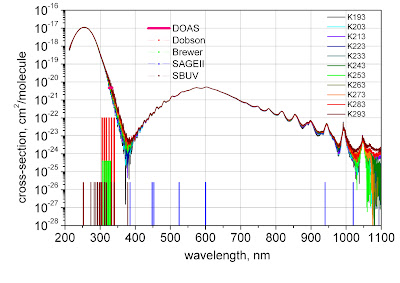 |
| Ozone absorption cross-sections. Image from IUP. |
To convert the
absorption cross-sections (units of cm^2/molecule) to absorption coefficients (units of cm^-1), I multiply by the molecular number density of standard air (units of molecules/cm^3), multiply by the concentration of ozone in the atmosphere (unitless), and then correct for altitude by multiplying by the relative density (unitless) at the altitude in question. The concentration of ozone varies a lot with altitude, but I just used the overall concentration, which is around
0.00006% (I wonder to what extent a more realistic distribution would affect my results). I packaged all of this up in a new Ozone class.
Below are some new renders with and without ozone absorption. These images are taken during twilight, looking straight up along the zenith.
 |
Twilight zenith sky with ozone.
Solar elevation angle: −5°. |
 |
Twilight zenith sky without ozone.
Solar elevation angle: −5°. |
Below are some more new renders (all with the same exposure) that show the effect of ozone absorption on the color of the sky. The previously intense orange at sunset is now much more subdued. The orange should become somewhat more saturated when I add aerosols to the atmosphere—an effect described in
The Influence of Ozone and Aerosols on the Brightness and Color of the Twilight Sky and in
Color and Light in Nature.
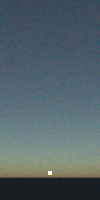 |
With ozone.
Solar elevation angle: 1°. |
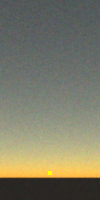 |
Without ozone.
Solar elevation angle: 1°. |
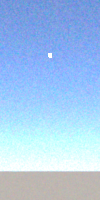 |
With ozone.
Solar elevation angle: 30°. |
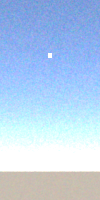 |
Without ozone.
Solar elevation angle: 30°. |
I'm pretty excited about these results. I think it's very interesting that Rayleigh scattering alone does not explain the blueness of the sky. According to
The Effect of Stratospheric Dust on the Color of the Twilight Sky, adding dust will increase the blueness of the twilight sky even more. I wonder whether implementing absorption by other gases would have any other noticeable effects on my results.
By the way, as far as I know, the existing sky simulations and analytic sky models in computer graphics do not consider the effects of ozone absorption.












